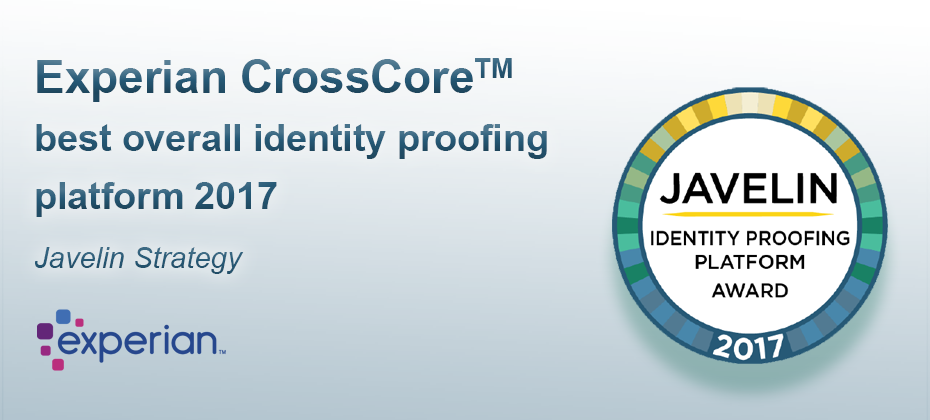Ecommerce / Retail

I recently sat down with Kathleen Peters, SVP and Head of Fraud and Identity, to discuss the state of fraud and identity, the pace of change in the space and her recent inclusion in the Top 100 influencers in Identity by One World Identity. ----------- Traci: Congratulations on being included on the Top 100 influencers list. What a nice honor. Kathleen: Yes, thank you. It is a nice honor and inspiring to be included among some great innovators in the industry. The list includes entrepreneurs to leaders of large organizations like us. It’s a nice mix across all facets of identity. T: Tell me about your role. How long have you been at Experian? K: I lead the team that defines the product strategy for our global fraud and ID portfolio. I’ve been with Experian just over four years, joining soon after we acquired 41st Parameter®. T: What was your first job? K: My first job out of college was with Motorola in Chicago. I was an electrical engineer, working on advanced cellphone technology. T: They were not able to keep up with the market? K: The entire industry was caught by the introduction of the iPhone. All the major cellphone companies were impacted — Nokia, Ericsson, Siemens and others. Talk about disrupting an industry. T: Yeah. These are great examples of how the disrupters have taken out the initial companies. Certainly, Motorola, Nokia, those companies. Even RIM Blackberry, which redefined the digital or cellular space, has all but disappeared. K: Yes, exactly. It was interesting to watch RIM Blackberry when they disrupted Motorola’s pager business. Motorola had a very robust pager line. Even then they had a two-way pager with a keyboard. They just missed the idea of mobile email completely. It’s really, really fascinating to look back now. T: Changing the subject a little, what motivates you to get out of bed in the morning? K: One of my favorite questions. I’m a very purpose-driven person. One of the things I really like about my role and one of the reasons I came to Experian in the first place is that I could see this huge potential within the company to combine offline and online identity information and transaction information to better recognize people and stop fraud. T: What do you see as the biggest threat to organizations today? K: I would have to say the pace of change. As we were just talking about, major industries can be disrupted seemingly overnight. We’re in the midst of a real digital transformation in how we live, how we work, how we share information and even how we share money. The threat to companies is twofold. One is the “friendly fire” threat, like the pace of change, disrupters to the market, new ways of doing things and keeping pace with that innovation. The second threat is that with digitization comes new types of security and fraud risks. Today, organizations need to be ever-vigilant about their security. T: How do you stay ahead of that pace of change? K: Well, my husband and I have lived in Silicon Valley since 1997. Technology and innovation are all around us. We read about it and we hear about it in the news. We engage with our neighbors and other people who we meet socially and within our networks. You can’t help but be immersed in it all the time. It certainly influences the way we go about our lives and how we think and act and engage as a family. We’re all technically curious. We have two kids, and our neighborhood high school, Homestead High, is the same high school Steve Jobs went to. It’s fun that way. T: Definitely. What are some of the most effective ways for businesses to combat the threat of fraud? K: I firmly believe that nowadays it all needs to start with identity. What we’ve found — and confirmed through research in our recent Global Fraud Report, plus conversations I’ve had with clients and analysts — is that if you can better recognize someone, you’ll go a long way to prevent fraud. And it does more than prevent fraud; it provides a better experience for the people you’re engaged with. Because once you recognize an individual, that initiates a trusted relationship between the two of you. Once people feel they’re in a trusted relationship, whether it’s a social relationship or a financial transaction, whatever the relationship is — once you feel trusted, you feel safe, you feel protected. And you’re more likely to want to engage again in the future. I believe the best thing organizations can do is take a multilayered approach to authenticating and identifying people upfront. There are so many ways to do this digitally without disrupting the consumer, and this is the best opportunity for businesses. If we collectively get that right, we’ll stop fraud. T: What are some of the things Experian is focusing on to help businesses stop fraud? K: We’ve focused on our CrossCore® platform. CrossCore is a common access and decisioning capability platform that allows the combining and layering of many different approaches — some active, some passive — to identify a customer in a transaction. You can incorporate things like biometrics and behavioral attributes. You can incorporate digital information about the device you’re engaging with. You can layer in online and offline identity information, like that from our Precise ID® product. CrossCore also enables you to layer in other digital attributes and alternative data such as email address, phone number and the validity of that phone number. CrossCore provides a great opportunity for us to showcase innovation, whether that comes from a third-party partner or even from our own Experian DataLabs. T: How significant do you see machine learning moving forward? K: Machine learning, it has all kinds of names, right? I think of machine learning, artificial intelligence, data robotics, parallel computing — all these things are related to what we used to call big data processing, but that’s not really the trendy term anymore. The point is that there is so much data today. There’s a wealth of data from all different sources, and as a society we’re producing it in exponential volumes. Having more and more and more data is not useful if you can’t derive insights from it. That’s why machine learning, augmented with human intervention or direction, is the best way forward, because there’s so much data out there available in the world now. No matter what problem we’re trying to solve, there’s a wealth of data we can amass, but we need to make sense of it. And the way to make sense of massive amounts of data in a reasonable amount of time is by using some sort of artificial intelligence, or machine learning. We’re going to see it in all kinds of applications. We already are today. So, while I think of machine learning as a generic term, I do think it’s going to be with us for a while to quickly compute and derive meaningful insights from the massive amounts of data all around us. T: Thanks, okay. Last question, and I hope a little fun. How would you describe yourself in one word? K: Curious. T: Ah, that’s a good choice. K: I am always curious. That’s why I love living where I live. It’s why I like working in technology. I’ve always wondered how things work, how we might improve on them, what’s under the hood. Why people make the decisions they do. How does someone come up with this? I’m always curious. T: Well, thank you for the time, and congrats again on being included in the Top 100 influencers in Identity.

“Who Moved My Cheese?” Perhaps you've heard of this popular book, released in 1998. If you haven't, it's a quick read and one that describes four fictional characters - two mice and two "little people" - on their quest to hunt for cheese. On their journey, they have to assess their routines and consider change - that word that makes so many of us uncomfortable. I bring this up because it is no secret that the consumer has changed dramatically over the years. Technology, the need for personalization, the demand for speed. Yes, the consumer has changed for sure, and everyone seems to recognize this but collections professionals. Look at any financial institution and you will hear and see leaders talking about and executing on digital acquisition and account management strategies. After all, digital is the medium that consumers desire when interacting with their financial service providers. Marketers know this and most have adapted, but when it comes to collections, the industry seems to be fixated on utilizing the tactics of the past. Today, collectors largely rely on calling consumers and sending out dunning letters. Right Party Contact rates continue to decline, and with 50 percent of consumers lacking land lines, the contact rates are only going to get worse. I say all this because if you want to see success, you must change. Offering your past-due customers a digital experience will not only increase your collections performance and recoveries, but simultaneously improve your customer experience and reduce costs. This is a huge opportunity if collectors would just embrace a digital collections strategy. And let me note that having a payment portal is not a digital collections strategy. If that was the case, digital marketers would be done with just a simple website, and then they can wish their consumers will land on the site. A digital collections experience is much more. Why stay stuck in the past? Change is good, let someone else look for that old cheese.

Traditional credit attributes provide immense value for lenders when making decisions, but when used alone, they are limited to capturing credit behavior during a single moment of time. To add a deeper layer of insight, Experian® today unveiled new trended attributes, aimed at giving lenders a wider view into consumer credit behavior and patterns over time. Ultimately, this helps them expand into new risk segments and better tailor credit offers to meet consumer needs. An Experian analysis shows that custom models developed using Trended 3DTM attributes provide up to a 7 percent lift in predictive performance when compared with models developed using traditional attributes only. “While trended data has been shown to provide additional insight into a consumer’s credit behavior, lack of standardization across different providers has made it a challenge to gain those insights,” said Steve Platt, Experian’s Group President of Decision Analytics and Data Quality. “Trended 3D makes it easy for our clients to get value from trended data in a consistent manner, so they can make more informed decisions across the credit life cycle and, more importantly, give consumers better access to lending options.” Experian’s Trended 3D attributes help lenders unlock valuable insights hidden within credit reports. For example, two people may have similar balances, utilization and risk scores, but their paths to that point may be substantially different. The solution synthesizes a 24-month history of five key credit report fields — balance, credit limit or original loan amount, scheduled payment amount, actual payment amount and last payment date. Lenders can gain insight into: Changes in balances over time Migration patterns from one tradeline or multiple tradelines to another Variations in utilization and credit limits Changes in payment activity and collections Balance transfer and debt consolidation behavior Behavior patterns of revolving trades versus transactional trades Additionally, Trended 3D leverages machine learning techniques to evaluate behavioral data and recognize patterns that previously may have gone undetected. To learn more information about Experian’s Trended 3D attributes, click here.

Expert offers insights into turnkey big data access The data is out there – and there is a lot of it. In the world of credit, there are more than 220 million credit-active consumers. Bolt on insights from the alternative financial services space and that number climbs even higher. So, what can analysts do with this information? With technology and the rise of data scientists, there are certainly opportunities to dig in and explore. To learn more, we chatted with Chris Fricks, data and product expert, responsible for Experian’s Analytical Sandbox™. 1. With the launch of Experian’s all-new Ascend platform, one of the key benefits is full-file access to our Sandbox environment. What exactly can clients access and are there specific tools they need to dig into the data? Clients will have access to monthly snapshots of 12-plus years of the full suite of Experian scores, attributes, and raw credit data covering the full national consumer base. Along with the data access, clients can interact and manipulate the data with the analytic tools they prefer. For example, a client can log into the environment through a standard Citrix portal and land on a Windows desktop. From there, they can access applications like SAS, R, Python, or Tableau to interrogate the data assets and derive the necessary value. 2. How are clients benefiting from this access? What are the top use cases you are seeing? Clients are now able to speed analytic findings to market and iterate through the analytics lifecycle much faster. We are seeing clients are engaging in new model development, reject inferencing, and industry/peer benchmarking. One of the more advanced use cases is related to machine learning – think of artificial intelligence for data analytics. In this instance, we have tools like H2O, a robust source of data for users to draw on, and a platform that is optimized to bring it all together in a cohesive, easy-to-use manner. 3. Our Experian database has details on 220 million credit-active consumers. Is this data anonymized, and how are we ensuring sensitive details are secure? We use the data from our credit database, but we’ve assigned unique consumer-level and trade-level encrypted pins to ensure security. Once the encrypted PINs are assigned, they remain the same over time. Then all PII is scrubbed and everything is rendered de-identifiable from an individual consumer and lender perspective. Our pinning technique allows users to accurately track individual trades and consumers through time, but also prevents any match back to individual consumers and lenders. 4. I imagine having access to so much data could be overwhelming for clients. Is more necessarily better? You’re right. Access to our full credit file can be a lot to handle. While general users will not “actively” use the full file daily, statisticians and data scientists will see an advantage to having access to the larger universe. For example, if a statistician only has access to 10% of the Sandbox and wants to look at a specific region of the country, they may find their self in a situation with limited data that it is no longer statistically significant. By accessing the full file, they can sample down based on the full population from the region they are concerned with analyzing. 5. Who are the best-suited individuals to dig into the Sandbox environment and assess trends and findings? The environment is designed to serve the front-line analysts responsible for coding and analytics that gets reported out to various levels of leadership. It also enables the socialization of those findings with leadership, helping them to interact and give feedback on what they are seeing. Learn more about Experian’s Analytical Sandbox and request a demo.

Experian® is honored to be an MRC Technology Award nominee. But we can’t win the MRC People’s Choice Award without your help! The annual MRC Technology Awards recognize the most elite solution providers making significant contributions in the fraud, payments and risk industries. CrossCore® is the first smart, open, plug-and-play platform for fraud and identity services. We know, and our clients agree, that it delivers a better way to modify strategies quickly, catch fraud faster, improve compliance and enhance the customer experience. Need further convincing? Here are the top 3 reasons you should vote for CrossCore. Reason 1: common access Manage your entire fraud and identity portfolio. Start immediately by turning on Experian services through a single integration. Connect to services quickly with a common, flexible API. Reason 2: open approach Control the data being used in decisions. CrossCore supports a best-in-class approach to managing a portfolio of services that work together in any combination — including Experian solutions, third-party services and client systems — delivering the level of confidence needed for each transaction. Reason 3: workflow decisioning Act quickly and adapt to new risks with built-in strategy design and workflow capabilities. You can precisely tailor strategies based on transaction type or risk threshold. Make changes dynamically, with no downtime. We hope you’ll vote for CrossCore as a better way to manage fraud prevention and identity services.

Consumers are hungry for more personalized marketing, and I’m an actual example. As a new stepmom to two young kids, who has a full-time job, I rarely have any down time. No revelation there. I no longer have time to surf the web to buy clothes. And shepherding everyone to an actual store to shop? #forgetaboutit I’m not alone. Of the 57 percent of women in the U.S. workforce, 70 percent have a child under the age of 18. We don’t always have the time to shop for clothes, financial products, and nearly anything else, but it doesn’t mean we don’t need or want to. I would give the right bank or retailer my data in exchange for personalized marketing offers in my inbox, social feeds and mailbox. And many others would, too. Sixty-three percent of Millennial consumers and 58 percent of Gen Xers are willing to share data with companies in exchange for personalized offers, discounts and rewards. This indicates consumers are craving more customized marketing. Providing their personal data to get that is acceptable to them. In the financial services space, Mintel research shows that just 61 percent of male consumers, 49 percent of consumers aged 18-44, and 44 percent of Hispanic Millennials have a general-purpose credit card, either with or without rewards (Mintel’s Marketing Financial Services Report for June 2017). This indicates a significant market opportunity for cards that offer segmented or boosted rewards based on specific sectors and categories. Here are some other interesting trends specific to financial services: Relying on Experts Although chatbots and robo-advisors allow easy access to many financial services, 81 percent of consumers prefer in-person meetings when it comes to personalized financial advice. According to Mintel, men aged 18-44 are most interested in a free consultation with a financial advisor, and 19 percent of consumers are open to a free consultation. This interest surpasses attending free classes about finance and receiving email and mobile alerts from a financial institution. Quick, Efficient Delivery While consumers are calling for increased personalization, they also want it delivered quickly and efficiently. These expectations create unique challenges for financial institutions of all sizes. Some banks have embraced “card finder” apps, which allow consumers the convenience of inputting personal information to generate customized offers. There is a huge opportunity for financial institutions to leverage available consumer data to understand their target audience, and then deliver relevant products via multiple channels where they are consuming media now. Those who do will be positioned to provide personalized financial recommendations that were impossible just a few years ago.

Early reports suggest the 2017 holiday season was a good one for retailers. Consumers were in the mood to spend, and as such, Americans’ total credit card debt continued to climb. Americans planned to spend $862 on gifts for the season, a huge jump from the $752 they planned on spending in 2016. And the numbers were significantly higher than their estimate in any November since 2007 -- just before the 2007-2009 recession. 29% of Americans said they planned to spend more than $1,000. What does this mean for card portfolios? Well, business is booming, but they should also prepare for the time of year when consumers are most apt to seek out debt consolidation and transfer options. A recent NerdWallet analysis revealed the average household that’s carrying credit card debt has a balance of roughly $15,654. Dig deeper into retail card specifically and reports indicate Americans are carrying $1,841 in retail debt. “There is seasonality to consumer credit card behavior,” said Denise McKendall, a credit card and trended data specialist for Experian. “As we roll into the late winter months and early spring, consumers often seek ways to transfer card debt to lower interest rate options, consolidate debt from multiple cards and perhaps even pull out personal loans. This makes it an ideal time for card portfolio managers to leverage data to anticipate consumer behaviors and be able to offer the best rates and options to retain cardholders and grow.” Card portfolio managers should consider these questions: What is my portfolio risk? Did some of my consumers overextend themselves? Do I have collections triggers on my accounts to mitigate risk and manage delinquencies? Which consumers in my portfolio will be looking to consolidate debt? Should I reassess credit line limits? Which of my consumers show a high propensity to make a balance transfer? Do I have opportunities to grow my portfolio by offering attractive rates to new customers? Which customers will leave after low introductory rates expire? Can I use this time of year to become the first credit card consumers’ consistently use, rather than the second or third card they pull from wallet? At first glance, it might appear challenging to answer many of these questions, but with the right data and analytics, a card manager can easily establish a game plan to conquest new business, mitigate risk and retain existing, high-value consumers. The robust holiday season was a boom for the economy. Now card companies need to ready themselves for the aftermath.

The nation’s economic recovery is continuing in a positive upward trend with consumer credit scores coming exceptionally close to pre-recession numbers—the healthiest in a decade. Experian’s 8th annual State of Credit report reveals the nation’s average credit score is up two points year-over-year to 675, and is just four points shy of the 2007 average of 679. “The trend line we are seeing is quite promising,” said Michele Raneri, Experian vice president of analytics and new business development. “With employment and consumer confidence on the rise, the data is indicating that we have made great progress as a country since the recession. The economy is expected to expand at a healthy pace this year and we believe that credit will continue to rebound. All of the factors point towards a good year for credit in 2018.” The study also revealed that year-over-year: Personal loan and auto loan originations increased 11 percent and 6 percent, respectively. The average number of retail cards remains at 2.5 per consumer, while the average retail debt increased $73 to $1,841 per consumer. The average number of bankcards increased slightly from 3.03 to 3.06, with the average card balance also increasing by $166 to $6,354. Instances of late payments (includes bankcard and retail) remained about the same at under 1 percent. And importantly, consumers have a positive outlook with consumer confidence up 25 percent. Top of the credit charts As part of the annual study, Experian analyzed consumer credit habits in U.S. cities. As in previous years, Minnesota continues to stand out with three of its cities — Minneapolis, Rochester and Mankato—leading the way with credit scores of 709, 708 and 708, respectively. Wausau, Wis. (706), Green Bay, Wis. (705) round out the top five. Again, Greenwood, Miss., and Albany, Ga., ranked the lowest with scores of 624 and 626. While still at the bottom of the list, Greenwood and Abany residents did improve their scores by two points. Riverside, Calif.,—fifth on the list—improved its score by four points—the greatest increase of any city in the bottom 10. Generational divide Taking the research further, Experian analyzed consumer credit information by generation, and found: Generation Z (born 1996 and later) is building credit through different methods than the generations before them, with heavier student loan debts and fewer credit cards and department store cards. And they are keeping debts low and managing them well. Generation Y/Millennials (born 1977-1995) have seen their scores climb four points over the past year. They’ve also decreased their overall average debt by nearly eight percent, but have added six percent in mortgage debt. Generation X (born 1965-1976) has a credit score of 658, the highest mortgage debt of all generations, and a high instance of late payments compared to the national average. Their scores have improved, so they are managing their debts better than in the past,. Baby Boomers (born 1946-1964) continue to carry quite a bit of mortgage debt, and have the lowest late payment instances of all the generations. The Silent Generation (born 1945 and before) has quite a bit of mortgage debt, but are keeping other debts low and making payments on time. At 729, they have the best credit score of all generations and the fewest late payments of any generation. To review findings from Experian’s 2017 State of Credit report, join WiseBread’s chat Jan. 18. To register, go to www.wisebread.com and follow #wbchat. To chat with Experian live, and learn more about credit, join #CreditChat hosted by @Experian_US on Twitter every Wednesday at Noon PT/3 p.m. ET.

Alternative Data Shedding New Light on Consumers Why Investors Want Alternative Data Banks and Tech Firms Battle Over Something Akin to Gold: Your Data Alternative data for credit has created national headlines in the past year and a lasting buzz in the financial services world. But what exactly qualifies as alternative data in credit? How can it benefit lenders? Consumers? Ask two people these questions and you may get very different answers. Experian defines alternative data as FCRA-compliant data points that are not typically considered when evaluating a potential customer’s creditworthiness. These data points may include rent payments; utility payments, including gas, electric; telecommunications payments, such as mobile telephones; insurance payments; and any other recurring financial obligations. Taking these alternative data points into account can benefit consumers and lenders in multiple ways. Consider that roughly 45 million Americans have either no credit history, or a credit history that is too scarce or outdated to manufacture a credit score. This group of consumers includes not only minority consumers or those from low income neighborhoods, but also the shared economy workforce and millennials without traditional credit histories. Some estimate 121 million U.S. adults are credit-challenged with thin-to-no credit file and subprime credit scores below 600. “People with little or no credit history, or who lack a credit score, have fewer opportunities to borrow money to build a future, and any credit that is available usually costs more,” said Richard Cordray, while he was director of the Consumer Financial Protection Bureau. Indeed, these consumers are in a catch-22; many lenders will not lend to consumers with credit scores of under 620. In turn, these consumers have trouble building credit, and they are blocked from achieving goals like buying a car, owning a home or starting a business. By combining credit reports with alternative data, a more complete picture of subprime, near-prime and thin-file consumers can develop. And analysis of this data can help lenders evaluate a consumer’s ability to pay. When alternative data like rent payments and an individual’s short term lending history are trended appropriately, it can be an accurate predictor of an individual’s financial behavior, and can be an important step toward promoting greater financial inclusion for more consumers. In addition to using alternative data in underwriting, lenders can leverage the data to help with: Expanding the prospecting universe. Data can be used to enrich batch prospecting decisioning criteria to identify better qualified prospects, suppress high-risk consumers, and offer a more complete borrowing history Account review. Alternative data can help signal a consumer’s financial distress earlier, better manage credit lines and grow relationships with existing consumers. Collections. Identify consumers who are rebuilding credit with specialty finance trades, or who are exhibiting high-risk behaviors in the alternative financial services space. More info on Alternative Credit Data More Info on Alternative Financial Services

Experian on the State of Identity podcast In today’s environment, any conversation on the identity management industry needs to include some mention of synthetic identity risk. The fact is, it’s top of mind for almost everyone. Institutions are trying to scope their risk level and identify losses, while service providers are innovating ways to solve the problem. Even consumers are starting to understand the term, albeit via a local newscast designed to scare the heck out of them. With all this in mind, I was very happy to be invited to speak with Cameron D’Ambrosi at One World Identity (OWI) on the State of Identity podcast, focusing on synthetic identity fraud. Our discussion focused on some of the unique findings and recommended best practices highlighted in our recently published white paper on the subject, Synthetic identities: getting real with customers. Additionally, we discussed how a lack of agreement on the definition and size of the synthetic identity problem further complicates the issue. This all stems from inconsistent loss reporting, a lack of confirmable victims and an absence of an exact definition of a synthetic identity to begin with. Discussions must continue to better align us all. I certainly appreciate that OWI dedicated the podcast to this subject. And I hope listeners take away a few helpful points that can assist them in their organization’s efforts to better identify synthetic identities, reduce financial losses and minimize reputation risks.

As we enter the holiday season, headlines abound around the shifts and trends in retail. How are consumers shopping? What are they buying online versus in-store? How can retailers maintain share and thrive? To gain some fresh perspective on the retail space, we interviewed John Squire, CEO and co-founder of DynamicAction, a business featuring advanced analytics solutions designed specifically for eCommerce, store and omnichannel retail teams. Squire has had a tenured career in the retail and technology sectors serving in key executive roles for IBM Smarter Commerce and Coremetrics. He has spent the past decade guiding nearly every retail brand to a better understanding of their customers and utilization of their data to make profitable decisions. Business headlines claim we are in the midst of a retail apocalypse. Is this statement a reality? The reality is that retail is in a renaissance – a revolution driven by the most empowered, connected consumer in history, a burgeoning technology infrastructure and retail tech innovators who have disrupted the status quo. The most agile of retailers and brands are leaning forward to serve their customer with remarkable experiences in the store, online and anywhere the customer decides to interact with the brand. And for those retailers, the days ahead are filled with newfound opportunity. However, the retailers and brands who don’t have a strong core purpose beyond being filler between anchor stores may no longer have a place in this new world of retail. The strongest retailers and brands will tap into their wealth of customer data to better understand, and therefore better serve their customers, creating long-term relationships. They should only continue gain in strength as consumers concentrate more and more of their time (and wallets) with businesses that passionately focus on their unique needs and buying patterns. It seems like shoppers are increasingly turning online to make their purchases. Is this the case, and do we see seasonal spikes with this trend? The key for successful retailers is to understand that customers aren’t just searching, browsing, buying and returning online OR in-store. They are shopping online AND in-store … and even online while in-store. Shoppers simply do not see channels, and the sooner that retailers reorganize their mindset, their organizations and their data understanding around this reality, the more successful they will become. Shoppers are indeed moving online with increasing frequency and larger amounts of their overall spending. Connecting data across the enterprise, across their partners and across social channels is critical in enabling their retailing teams to make decisions on how best to simultaneously serve their customers and their company’s shareholders. If retailers have a store credit card to offer to consumers, how can they encourage use and get them to maximize spend? Are there particular strategies they should employ? As with any loyalty program or service item, consumers are looking for tools and offers they value. Therein lies the opportunity and the challenge. Value can come in many forms, depending on the individual. Does the credit card offer travel or retail points, or dollars that they can accumulate? Does the credit card save them time? Provide them with additional purchasing power? Reduce their friction of making large purchases? Increase the security of the initial purchase and long-time use of the product or service? The competition for just a consumer’s current and future wallet is being upended by retailing offers that are serving up entertainment, services, convenience and broader product selections. Understanding the high-value activities correlated to their VIP consumers generating the highest amount of profit for the business is the essential to building strategies for encouraging card use. Beyond online shopping, are there other retail trends you see emerging in the coming year? What excites you about the space? Online shopping is not a trend; it is retail’s greatest disruption of the last 100 years. Digitization of shopping in both the online and store setting is what thrills me. One to watch is Wal-mart. The company is taking a highly energized track to build a business of next-gen brands and using their supply chain acumen to battle Amazon, while simultaneously gaining huge amounts of market share from other less sophisticated and strong retailers. In addition, seeing how next-gen brands like Warby Parker, Everlane, Untuckit, Bonobos, Indochino and Rent the Runway are rapidly building out a store experience, albeit radically different than the stores of the past, is exciting to watch. Seeing the growth in Drone deliveries outside the US for retail and commercial applications is surely the next big jump for ‘Next Hour’ in-home delivery. Made-to-order with a very short lead-time is also a big trend to keep an eye on. However, what excites me most in the industry is the universal mind shift that is becoming undeniable in retail: that data understanding and action will be the very basis for customer centricity and companies’ growth. Retailers have had access to these data pools for ages, but the ability to sync the data sets across channels, make sense of the findings and take action at the speed the consumer expects is truly the next leap forward for great retailers. To learn more about the state of retail credit cards, access our latest report.

The data to create synthetic identities is available. And the marketplace to exchange and monetize that data is expanding rapidly. The fact that hundreds of millions of names, addresses, dates of birth, and Social Security numbers (SSNs) have been breached in the last year alone, provides an easy path for criminals to surgically target new combinations of data. Armed with an understanding of the actual associations of these personally identifiable information (PII) elements, fraudsters can better navigate the path to perpetrate identity theft, identity manipulation, or synthetic identity fraud schemes on a grand scale. Using information such as birth dates and addresses in combination with Social Security numbers, criminals can target new combinations of data to yield better results with lower risk of detection. Some examples of this would be: identity theft, existing account takeovers, or the deconstruction and reconstruction of those PII elements to better create effective synthetic identities. Experian has continued to evolve and innovate against fraud risks and attacks with an understanding of attack rates, vectors, and the shifting landscape in data availability and security. In doing so, we’ve historically operated under the assumption that all PII is already compromised in some way or is easily done so. Because of this, we employ a layered approach, providing a more holistic view of an identity and the devices that are used over time by that identity. Relying solely on PII to validate and verify an identity is simply unwise and ineffective in this era of data compromise. We strive to continuously cultivate the broadest and most in-depth set of traditional, innovative and alternative data assets available. To do this, we must enable the integration of diverse identity attributes and intelligence to balance risk, while maintaining a positive customer experience. It’s been quite some time since the use of basic PII verification alone has been predictive of identity risk or confidence. Instead, validation and verification is founded in the ongoing definition and association of identities, the devices commonly used by those individuals, and the historical trends in their behavior. Download our newest White Paper, Synthetic Identities: Getting real with customers, for an in-depth Experian perspective on this increasingly significant fraud risk.

If someone asked you for stats on your retail card portfolio, would you respond with the number of accounts? Average spend per month? Or maybe you know the average revolving balance and profitability. Notice something about that list? Too many lenders think of their portfolio and customers as numbers when in reality these are individuals expressing themselves through their transactions. In an age where consumers increasingly expect customized experiences, marketing to account #5496115149251 is likely to fall on deaf ears. Credit card transaction data including bankcard, retail, and debit cards holds a wealth of information about your consumers' tastes and preferences. Think about all the purchases you made using a credit card this past month. Did you shop at high-end retail stores or discount stores? Expensive restaurants or fast food? Did you buy new clothes for your kids? Maybe you went to the movies, or met friends at a bar. How you use your card paints a picture of who you are. The trick is turning all those numbers into insights. You may have been swept up in all the excitement around Apple’s announcement of the iPhone X in August. However, you may have overlooked the incorporation of Neural Embedding, or machine learning, as one of the most powerful features of the new phone. Experian DataLabs has developed an innovative approach to analyzing transaction data using similar techniques. Unstructured machine learning is applied and patterns begin to emerge around customer spending. The patterns are highly intuitive and give personality to what was previously an indecipherable stream of data. For example, one group may be more likely to spend on children’s clothing, child care services, and theme parks while another spends on expensive restaurants, airlines, and golf courses. If these two consumers happened to spend approximately the same each month on your card, you’d probably treat them as category. But understanding one is a young family and their other is jet setter allows you to tailor messaging, offers, and terms to their needs and use of your products. Further, you can ensure they have the best product based on their lifestyle to minimize silent attrition as their needs evolve. But it’s not just about marketing. When your latest attrition dashboard is updated, what period are you measuring? Do you analyze account closures from the previous month? Maybe a few months back? Understanding churn is important, but it’s inherently reactive and backward looking. You wouldn’t drive a car looking in the rearview mirror, would you? Experian enables clients to actively monitor the portfolio for attrition risk by analyzing usage patterns and predicting future spend. Transactions are then monitored up to daily and, when spend doesn’t occur as expected, an alert is sent so you can proactively attempt to save the account before it closes. These algorithms are finely tuned to reduce false positives that can come from seasonality or predictable gaps in spend such as only using a card at certain times during the week. Most importantly, it gives you an opportunity to manage each account and address changing customer needs instead of waiting for customers to call to cancel. So how well do you know your customers? If you’re still looking at them as numbers, it may be time to explore new capabilities that allow you to act small, no matter how large your portfolio. Transaction Data Insights brings cutting-edge machine learning capabilities to lenders of all sizes. By digging into behavioral segments and having tools to monitor and send alerts when a consumer is showing signs of attrition risk, card portfolios can suddenly treat customers like people, providing the customized experience they increasingly expect.

Earlier this week, Javelin Strategy & Research announced its inaugural edition of the 2017 Identity Proofing Platform Awards. We were honored to see CrossCore as the leader – taking the award for the best overall identity proofing platform. According to the report, “Experian’s identity proofing platform is a strong performer in every category of Javelin’s FIT model. It is functional. It is innovative. And, most important, it is tailored toward the advisory’s expectations. The comprehensive nature of CrossCore makes it the market-leading solution for identity proofing.” It’s harder than ever to confidently identify your customers in today’s digital economy. You have lots of vendor solutions to choose from in the identity proofing space. And, now Javelin has made it much easier for you to select the partner that is right for your needs. Javelin’s newly minted Identity Proofing Platform Scorecard assesses current capabilities in the market to help you make that decision. And they have done a lot of the heavy lifting, looking across 23 vendors and scoring them based on three categories of their FIT model – functional, innovative, and tailored. Protecting customers is a priority for you – and for us. Here at Experian, we have a range of capabilities to help businesses manage identity proofing, and our CrossCore platform brings them all together. We launched CrossCore last year, with the goal of making the industry’s fraud and identity solutions work better for everyone. CrossCore delivers a future-proof way to modify strategies quickly, catch fraud faster, improve compliance and enhance the customer experience. We’re proud of the work we’ve done so far, integrating our products as well as adding more than 10 partners to the program. We’re pleased to see so many of our partners included in Javelin’s report. We’re working closely with our clients to pull in more partner capabilities, and further enhance our own platform to create a layered approach that supports a risk-based, adaptable strategy. As highlighted in the Javelin report, a reliance on traditional identity verification approaches are no longer sufficient or appropriate for digital channels. With CrossCore, our clients can choose the capabilities they want, when they want them, to dial in the right confidence level for each and every transaction. This is because CrossCore supports a layered approach to managing risk, allowing companies to connect multiple disparate services through a common access point. We are committed to making it easier for you to protect consumers against fraud. CrossCore is helping us all do just that.

The collections space has been migrating from traditional mail and outbound calls to electronic payment portals, digital collections and virtual negotiators. Now that collectors have had time to test virtual collections, we’ve collected some data points. Here are a few: On average, 52% of consumers who visit a digital site will proceed to a payment schedule if the right offer is made. 21% of the visits were outside the core hours of 8 a.m. to 8 p.m., an indication that traditional business hours don’t always work. Of the consumers who committed to a payment plan, only 56% did it in a single visit. The remaining 44% did so mostly later that day or on a subsequent day. As more financial institutions test this new virtual approach, we anticipate customer satisfaction and resolutions will continue to climb. Get your debt collections right>